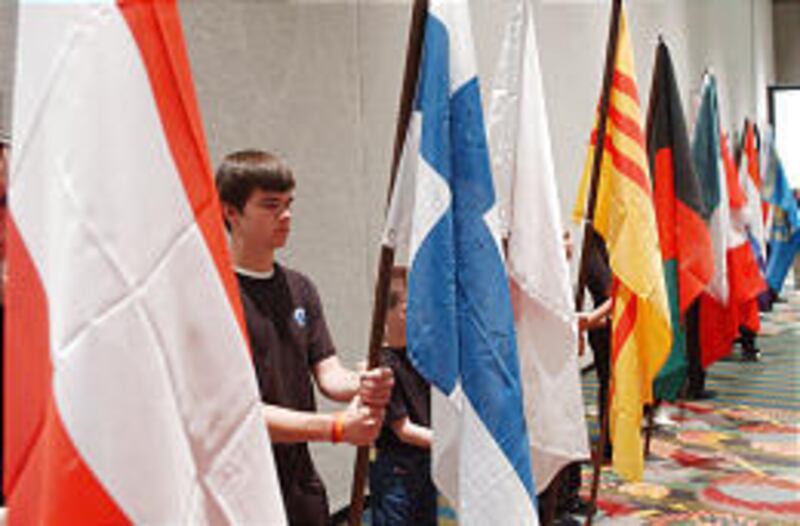Now is the time to start training young people who will go to Mars, says the first person to walk in space.
Gen. Alexei Leonov, the Russian whose dangerous excursion outside the Vostok capsule thrilled the world in 1965, said Monday that if the nations of the world were to agree today that a voyage to Mars was a priority, it would still take 16 or 17 years of development before a crew lands there. So it's important to begin teaching young future explorers about the project, he said.
"There are plans, and there is a lot of work ahead of us," he said, "so let's get to work."
Leonov is among a constellation of approximately 60 astronauts and cosmonauts, representing 11 countries, who have gathered in the Salt Palace for the 19th annual meeting of the Association of Space Explorers. The weeklong session was organized by former Sen. Jake Garn, R-Utah, whose own flight aboard the Space Shuttle Discovery was in 1984.
This is the second time the association's annual planetary congress has been held in the United States, and on Monday, the meeting opened with a flourish.
Schoolchildren carried in flags representing the countries of all of those who have flown, nearly 30 nations. They walked up the Grand Ballroom's center aisle, then turned and posted the flags along opposite walls.
A crowd of astronauts, cosmonauts and their families followed the flag-bearers and took their seats in reserved sections. They included Utah natives Don Lind, who flew in Skylab in 1985, and Garn.
Many others in the group were famous, such as Scott Carpenter, who piloted America's second orbital flight in 1962; Japanese journalist Toyohiro Akiyama; and Gen. Tom Stafford, who orbited the moon during the first landing in 1969.
Also among them was Charlie Precourt, who flew in space four times in the 1990s. Precourt recently moved to Utah work for ATK Thiokol, makers of the solid fuel rockets that help power the shuttle. Thiokol's reusable booster has been earmarked for the first stage of the shuttle's replacement, and the company is one of the meeting's sponsors.
Gov. Jon Huntsman Jr. welcomed the explorers, comparing the linking of the American coasts by the transcontinental railroad in 1869 to the linking of Earth and the moon 100 years later.
"We have many pioneers today in our midst," the governor added. He said one of the most exciting events of the meeting will be the outreach day, Wednesday, when astronauts and cosmonauts will visit every school district in Utah.
The visits will remind students "that we have modern-day heroes in our midst," and the meetings may inspire the youngsters.
Garn said he has spent the past 20 years trying to explain that beyond the thrill of looking at the Earth from orbit, there is a feeling of friendship "that knows no national boundaries." Differences of speech, color, homeland aren't important from that perspective, he said.
"We are all traveling on Spaceship Earth together," Garn said.
Monday was a day for great stories, from Garn's tale about accidentally "killing" Leonov during the crash of a spaceflight simulator, to Leonov's relating his struggle to reenter Vostok after his space walk.
The vacuum of space caused his spacesuit to balloon up. "I'm looking like a Michelin man," he said. "Yeah! It was very difficult to pull inside."
Leonov struggled but could not fit back into the hatch. As he tried to get back in with five minutes' air left in his spacesuit, his heart rate reached 160 a minute.
At last, he managed to deflate the suit and reenter the capsule. "But I did it. I did it. I did it," he said, still relieved.
Leonov said he decided to deviate from plan and partly deflate the spacesuit without telling ground control. If he had described his problem, he added, people on the ground would have held a meeting, debated the issue, then — 20 minutes later, they would have recommended "you must change pressure."
When the Deseret Morning News asked Carpenter how long it would be before humans land on Mars, he said "it's up to you and your country, because we know how to do it now." That is, he added, it depends on the commitment of time, money and determination.
"All things being equal, the flight to Mars is doable and probably will be achieved in the next 20 years," Carpenter added.
Events today include the appearance of Col. Rick Searfoss, a member of The Church of Jesus Christ of Latter-day Saints and former astronaut, at Clark Planetarium, 1 to 5 p.m. Anyone may walk in and talk with him, and he will sign autographs, according to a statement. Searfoss, who flew in space three times, is involved in the development of private citizen spaceflight.
On Wednesday, Clark Planetarium will host a public event with Vance D. Brand, a commander on the joint U.S.-Soviet flight, Soyuz-Apollo, 30 years ago. The session is 7 to 9 p.m. and tickets are limited.
E-mail: bau@desnews.com


